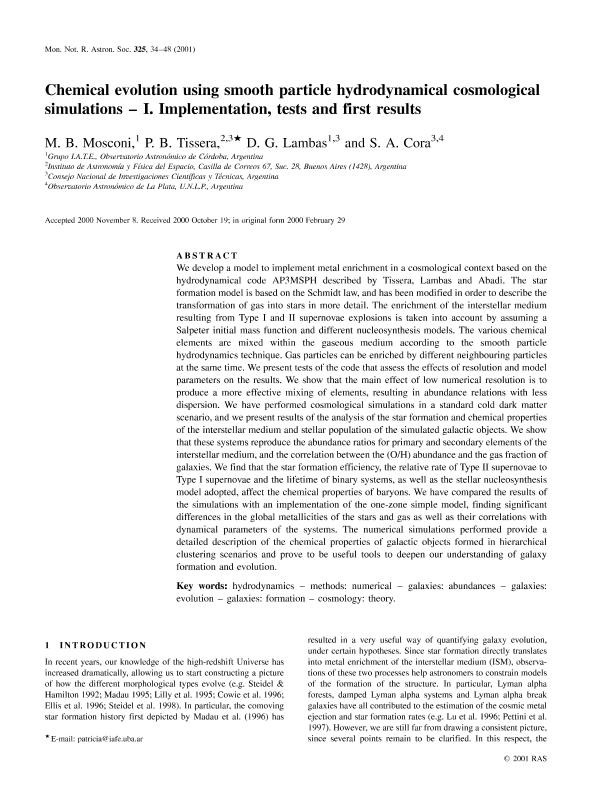Mostrar el registro sencillo del ítem
dc.contributor.author
Mosconi, M. B.
dc.contributor.author
Tissera, Patricia Beatriz

dc.contributor.author
Garcia Lambas, Diego Rodolfo

dc.contributor.author
Cora, Sofia Alejandra

dc.date.available
2017-08-15T17:24:45Z
dc.date.issued
2001-07
dc.identifier.citation
Mosconi, M. B.; Tissera, Patricia Beatriz; Garcia Lambas, Diego Rodolfo; Cora, Sofia Alejandra; Chemical evolution using smooth particle hydrodynamical cosmological simulations - I. Implementation, tests and first results; Oxford University Press; Monthly Notices of the Royal Astronomical Society; 325; 1; 7-2001; 34-48
dc.identifier.issn
0035-8711
dc.identifier.uri
http://hdl.handle.net/11336/22481
dc.description.abstract
We develop a model to implement metal enrichment in a cosmological context based on the hydrodynamical code AP3MSPH described by Tissera, Lambas and Abadi. The star formation model is based on the Schmidt law, and has been modified in order to describe the transformation of gas into stars in more detail. The enrichment of the interstellar medium resulting from Type I and II supernovae explosions is taken into account by assuming a Salpeter initial mass function and different nucleosynthesis models. The various chemical elements are mixed within the gaseous medium according to the smooth particle hydrodynamics technique. Gas particles can be enriched by different neighbouring particles at the same time. We present tests of the code that assess the effects of resolution and model parameters on the results. We show that the main effect of low numerical resolution is to produce a more effective mixing of elements, resulting in abundance relations with less dispersion. We have performed cosmological simulations in a standard cold dark matter scenario, and we present results of the analysis of the star formation and chemical properties of the interstellar medium and stellar population of the simulated galactic objects. We show that these systems reproduce the abundance ratios for primary and secondary elements of the interstellar medium, and the correlation between the (O/H) abundance and the gas fraction of galaxies. We find that the star formation efficiency, the relative rate of Type II supernovae to Type I supernovae and the lifetime of binary systems, as well as the stellar nucleosynthesis model adopted, affect the chemical properties of baryons. We have compared the results of the simulations with an implementation of the one-zone simple model, finding significant differences in the global metallicities of the stars and gas as well as their correlations with dynamical parameters of the systems. The numerical simulations performed provide a detailed description of the chemical properties of galactic objects formed in hierarchical clustering scenarios and prove to be useful tools to deepen our understanding of galaxy formation and evolution.
dc.format
application/pdf
dc.language.iso
eng
dc.publisher
Oxford University Press

dc.rights
info:eu-repo/semantics/openAccess
dc.rights.uri
https://creativecommons.org/licenses/by-nc-sa/2.5/ar/
dc.subject
Hidrodynamics
dc.subject
Numerical
dc.subject
Galaxies
dc.subject.classification
Astronomía

dc.subject.classification
Ciencias Físicas

dc.subject.classification
CIENCIAS NATURALES Y EXACTAS

dc.title
Chemical evolution using smooth particle hydrodynamical cosmological simulations - I. Implementation, tests and first results
dc.type
info:eu-repo/semantics/article
dc.type
info:ar-repo/semantics/artículo
dc.type
info:eu-repo/semantics/publishedVersion
dc.date.updated
2017-08-14T19:51:24Z
dc.journal.volume
325
dc.journal.number
1
dc.journal.pagination
34-48
dc.journal.pais
Reino Unido

dc.journal.ciudad
Londres
dc.description.fil
Fil: Mosconi, M. B.. Consejo Nacional de Investigaciones Científicas y Técnicas. Centro Científico Tecnológico Conicet - Córdoba. Instituto de Astronomia Teórica y Experimental. Universidad Nacional de Córdoba. Observatorio Astronómico de Córdoba. Instituto de Astronomia Teórica y Experimental; Argentina
dc.description.fil
Fil: Tissera, Patricia Beatriz. Consejo Nacional de Investigaciónes Científicas y Técnicas. Oficina de Coordinación Administrativa Ciudad Universitaria. Instituto de Astronomía y Física del Espacio. - Universidad de Buenos Aires. Facultad de Ciencias Exactas y Naturales. Instituto de Astronomía y Física del Espacio; Argentina
dc.description.fil
Fil: Garcia Lambas, Diego Rodolfo. Consejo Nacional de Investigaciones Científicas y Técnicas. Centro Científico Tecnológico Conicet - Córdoba. Instituto de Astronomia Teórica y Experimental. Universidad Nacional de Córdoba. Observatorio Astronómico de Córdoba. Instituto de Astronomia Teórica y Experimental; Argentina
dc.description.fil
Fil: Cora, Sofia Alejandra. Consejo Nacional de Investigaciones Científicas y Técnicas. Centro Científico Tecnológico Conicet - La Plata. Instituto de Astrofísica La Plata. Universidad Nacional de La Plata. Facultad de Ciencias Astronómicas y Geofísicas. Instituto de Astrofísica la Plata; Argentina. Universidad Nacional de La Plata. Observatorio AstronoÂmico de La Plata; Argentina
dc.journal.title
Monthly Notices of the Royal Astronomical Society

dc.relation.alternativeid
info:eu-repo/semantics/altIdentifier/url/https://academic.oup.com/mnras/article-lookup/doi/10.1046/j.1365-8711.2001.04198.x
dc.relation.alternativeid
info:eu-repo/semantics/altIdentifier/doi/http://dx.doi.org/10.1046/j.1365-8711.2001.04198.x
Archivos asociados
